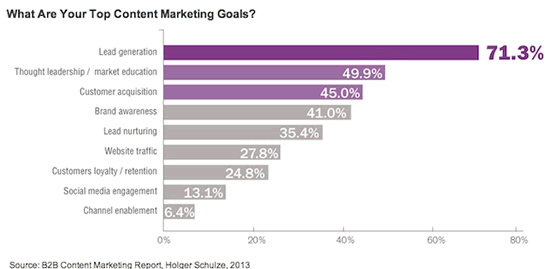 Thought leadership and content : can you separate both? Look at any content marketing survey and there it is: the second most important reason businesses ‘do’ content marketing and deploy a content marketing plan is ‘thought leadership’.
Thought leadership and content : can you separate both? Look at any content marketing survey and there it is: the second most important reason businesses ‘do’ content marketing and deploy a content marketing plan is ‘thought leadership’.
Just check out the chart MarketingProfs made, based on a 2013 B2B content marketing survey. Lead generation…leads, thought leadership and market education rank second. Take any other content marketing survey and you’ll notice thought leadership is mentioned as an essential goal too. In B2C it’s even more important and once you start filtering and segmenting research, often thought leadership comes very close to usual suspects such as lead generation (too bad customer retention and service are always lagging behind BTW).
The conclusion is clear: we want our businesses (and people) to be thought leaders.

What is thought leadership? It used to mean being the person journalists and people went to when they wanted expert advice on any given topic.
What does it mean now? Many things to many people. Do you still know what thought leadership is? Are people providing context on TV about a topic thought leaders in that specific area? It depends. If you’re an expert in that area too you probably often ask yourself what the heck the invited thought leader is saying. If you know nothing about the topic, you probably think you’re listening to a genuine expert. Perception matters. Today perception matters even more. And with the advent of that somewhat intangible and vague concept of social influence, thought leadership has gone wild and became an obsession for many, with some playing the game of perception better than others. Don’t misunderstand me: thought leadership is a strong thing.
“Good content management and knowing where you store, update and find the right content to answer people’s questions, whether it’s to be a thought leader, helpful to a customer or just giving, is essential”
So, now we link content marketing to thought leadership too. Well, we always did in fact. The link between content management, the use of content and this whole thought leadership thing was always strong. It had to do with genuine thought leadership, expertise and that “old” concept of ‘being top of mind’. And with help.
The idea as it’s carried out in this ‘social’ and ‘content marketing’ age seems simple: put out smart, engaging and customer-centric content on the topics/values your brand relates with, what your target audiences want/like and ideally created by the people within your organization – if you’re not a faceless company – and you can be a thought leader. Well, it doesn’t end there. There’s a lot more to say about influence, thought leadership, subject matter expertise, content, social etc. but let’s look a bit deeper into thought leadership as such and the role of content management.
Some thoughts/lessons on thought leadership
- Your business goal is not thought leadership. It’s being where and when it matters for your customers and your real business goals. Thought leadership is about being contacted and coming to mind when someone wants your advice or help. It’s about getting in the inner circles of trust by being helpful and trustworthy. It’s about creative and actionable business thinking turned into value and support. The best thought leaders know their goals and achieve them, even if it means they’re sometimes less visible or popular or influential. Thought leadership is about trust and integrity in the sense that when you have something to say, it’s useful saying it. When you don’t have something to offer, you listen. Thought leadership is earned through intelligent observation and perceptive insight into what people will pay attention to.
- Thought leadership requires targeted focus. It’s about trusted advisorship. And it requires you to focus, using content or simply interacting, on a group of people and topics you know inside out. I know, on the Web it’s a lot about noise too and you can be perceived as a thought leader, just based on, let’s say, blog posts. But, thought leadership is not about (only) content or influence. You don’t have to be the Justin Bieber in your field of expertise and business. Look at it the long term and remember that we all need a social place in an environment where growth goes beyond the heat of spotlights. But if you’re a fan of spotlights: feel free to become more than a highly trusted and respected person. If you want business: focus. The most sought-after thought leaders in the ICT industry, for instance, are analysts and other ‘visible’ people that specialize in a few topics. This doesn’t mean there is no room for generalists. It’s just harder, people like to stick a label and, let’s face it, it takes time to be an expert in a domain. A second dimension of focus is the business and ecosystem in which you operate. Let me refer to well-known analysts in specific verticals or really nice IT domains again: they are often less visible (also online) but they are highly respected. If you have just read between the lines: thought leadership does not necessarily mean online visibility…
- Thought leadership is about perception and as I said it’s more so than ever. I wish it was somewhat different but unfortunately it isn’t: if you’re the most helpful, smart, nice and empathic person within your area of expertise you’re not per se a thought leader. Times have changed. Great people-oriented subject matter experts need to be visible and speak out in a more or less public way to be perceived as thought leaders. Like it or not: personal branding plays a huge role now and sadly it’s often about shouting and creating popular content, even if perceived thought leaders sometimes have zilch practice experience in the topics they write or talk (or shout) about. That’s not always a must:don’t think the best analysts, subject matter experts or journalists on any given subject always have practice experience. We can’t all become presidents or senators but we can be brilliant political analysts. In marketing, practice and experience obviously is more important. But the outside look is often essential too.
- Thought leadership is about long-term results and relationships. Here’s the long term again. And results. And relationships. Just ask yourself this simple question: do you prefer to be a trusted advisor of true decision makers, even if it’s often invisible or do you prefer a few years or a decade of ‘fame’? Because relationships that are mutually valuable and based on trust really take a genuine effort and long-term mindset. They need you to be non-stop relational (which doesn’t mean you have to interact the whole time, I’m talking truly relational). Sure, some can combine both. But not many can. There’s nothing wrong with feeling good about being popular or famous. It becomes a problem in the long run if you forget focusing on the fact that (business) relationships really require some form of quid pro quo and don’t always go well together with an unbalanced obsession about the own needs and goals… You know the saying: there is no ‘I’ in team (well, there is in a sense – sayings are just sayings – but you know what I mean).
- Real thought leaders create practice leaders thinking and acting out of the box. Thought leadership is not just about you or your business. And it’s not just about thoughts. It’s about providing customers and others with the thoughts and expertise that makes them practice leaders that can think out of the box because you do and show them paths to succeed. Thought leaders are not eternal helpers, they get the best out in people because in the end there’s an army of subject matter experts and potential thought leaders that’s never heard or to scared to voice their views and experiences. Kill those dragons and get that subject matter expertise, brilliant thinking and simple know-how of where to find the right answers to people’s questions ‘out there’.
- Thought leadership has to lead. It brings people somewhere, just as leadership is about getting something done, within a social context.
Thought leadership and information management: listening, organizing and helping
So, what does all this have to do with content marketing and content management?
I guess I’m not saying anything new if I make a connection between content marketing and thought leadership. But there is a link between content/information management and thought leadership we often overlook.
Let’s assume thought leadership that “works” in the long run is a lot about being helpful and responsive in many possible – focused – ways (you can disagree). In many cases the best way to be helpful is by providing information people seek in order to see their challenges and questions solved. As an experienced subject matter expert and a human being it’s great when you can do that. This doesn’t mean content is just about providing information and help. Content is also about emotion (a lot in fact, more than most realize). It also doesn’t mean that help is just about information and content. When I can connect someone who seeks a candidate for a job on LinkedIn and there’s a match I help as well.
“Real thought leaders create practice leaders thinking and acting out of the box”
But in the information age, information and content simply are among your best ‘tools’ to serve customers, help people and do what you typically do in solid relationships.
One of the big misconceptions I often hear is that thought leadership and content/information in this context are about creating content and content marketing in the strict sense. Yes, you need to create and use content where it matters but it’s not enough. Good content management and knowing where you store, update and find the right content to answer people’s questions, whether it’s to be a thought leader, helpful to a customer or just giving, is essential too.
Information put at use: opening the right drawers
 I’m not even talking about content curation and whatnot here. I’m talking about having fast access to all information and content in the organization, your area of expertise and the ecosystem of the business. I’m talking about the capability to listen and truly understand what folks are searching for and to get it for them based on a solid information management approach and capability to turn proven experience into useful information, distinguishing between popular stuff and the really helpful information and content. It doesn’t take a content creator to achieve that.
I’m not even talking about content curation and whatnot here. I’m talking about having fast access to all information and content in the organization, your area of expertise and the ecosystem of the business. I’m talking about the capability to listen and truly understand what folks are searching for and to get it for them based on a solid information management approach and capability to turn proven experience into useful information, distinguishing between popular stuff and the really helpful information and content. It doesn’t take a content creator to achieve that.
Creating content customers, prospects and audiences need or like is essential for many purposes and in many context but thought leadership and content creation are not one and the same.
Again, content isn’t enough. What it does require is being passionately up-to-date about what you do/learn/know, understanding what matters and where it sits to get it out at the right time. It’s about opening the right drawer and get what people need out of it fast. Including the drawers in your head, that maybe one day will be merged with the digital drawers if we can believe AI futurists.
Real thought leadership is not about leading thoughts but in a sense about storing, classifying and retrieving useful information when and where it matters. It’s also about turning proven experience, expertise and helpful information, both human and digital, into relational value and benefits. Focused and accurate: know-how turned into thought leadership and trusted advisorship when it gets shared with the right people at the right time. Or in other words: focus on usefulness.
Provide what “others” need to succeed. Identify those potential thought leaders, empower them by sharing your lessons and connect both the dots and the docs. Isn’t that what information and enterprise content management is partially about, as much as content marketing and relationship marketing should be?

